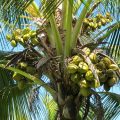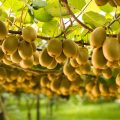Brontispa, one of the most damaging pests of coconut and other palms, has apparently found another equally notorious match — the dreaded coconut scale insect (CSI) or scientifically named as Aspidiotus sp. Signoret.
Equipped with specialized mouthparts for sucking, this small yet terribly voracious pest feeds on sap directly from the tree’s vascular system.

CSI’s feeding causes yellowing or chlorosis, wilting, premature nutfall, and low yield.
Experts explain that as CSI sucks the sap and injects toxic enzymes, these result to discolored leaves and deformed plant tissues.
Usually a minor pest of young coconut in nurseries, CSI is also a destructive pest to mature coconut palms. As they settle on the leaves, they continuously suck the sap that is essential for the growth of the crop.
In young palms, this pest appears on the underside of coconut palms. In bearing palms, it also attacks the surface of the fruits and the petioles.
Coconut plantations in Batangas attest to how menacingly destructive CSI can become. Having been first noticed in three barangays of Tanauan in 2011, CSI has spread in nearby coconut farm towns of Sto. Tomas, Laurel, Malvar, Lemery, Agoncillo, and Balete.
Recent report shows that CSI has now affected about 780,000 coconut trees in nine municipalities of Batangas including nearby provinces, Laguna, Quezon, and Cavite.
The havoc caused by the pest was enough for the affected communities to declare a state of calamity. Farmers were forced to cut down infested trees and sell them as lumber to mitigate losses.
All is not well for this vicious pest though. Hopefully, with the right technology, it can also be controlled, as it was in other countries. In controlling the disease, experts recommend the use of an integrated management approach. Such approach must begin with the early detection and identification of the pest.
On young palms and seedlings, CSI can be controlled manually by picking them off or spraying them off with a jet of warm water or by leaf pruning.
The use of insecticide is advised in some instances, particularly when other methods proved unsatisfactory.
Effective insecticides can lower CSI population in the field dramatically but it is important to select appropriate insecticides; observe timing and application methods to protect CSI’s natural enemies; and avoid environmental contamination to protect human health and economic viability of the enterprise.
As proven by many countries with coconut scale infestation, biological control can be a long-term solution for the control of this pest. This calls for the use of known predators and parasites that can regulate CSI populations. Such biological agents may consist of coccinellid beetles, lacewings, and parasitic wasps.
Being in the forefront of the battle against CSI, the Philippine Coconut Authority (PCA) sees the need to fast track the mitigation of pest infestation and slow down the rate of infestation to allow the recovery of severely damaged palms.
PCA likewise sees the importance of a science and technology-based mapping of CSI infestation and evaluation of the efficient and safe delivery system of chemical treatments.






